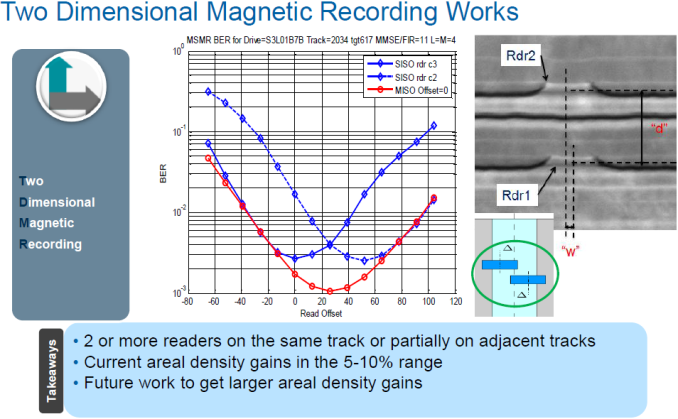The Evolution of HDDs in the Near Future: Speaking with Seagate CTO, Mark Re
by Anton Shilov on July 6, 2016 2:00 PM ESTTwo-Dimensional Magnetic Recording Due in 2017
Two-dimensional magnetic recording (TDMR) is a yet another technology that should help to increase areal density and this is something that Seagate is investing in. The manufacturer believes that TDMR helps to increase areal density by 5% to 10%. Plans were announced several months ago and during the conversation with Mark Re, it was confirmed that Seagate was on track to release its first commercial TDMR-based HDDs in 2017.
TDMR technology enables makers of hard drives to increase the areal density of HDD platters by making tracks narrower and pitches even smaller than they are today. While it is possible to minimize the writer (a part of an HDD's head that writes data), reading becomes a challenge. As magnetic tracks become narrower, they start to affect each other, an effect called magnetic inter-track interference (ITI). This means It becomes increasingly hard for HDD heads (readers) to perform read operations. To mitigate the ITI effect of very narrow tracks, two-dimensional magnetic recording technology uses an array of heads to read data from either one, or several nearby tracks (a method described in several scientific publications). This improves the signal-to-noise ratio delivered to the controller. Several readers enable HDD controllers to determine the correct data based on input from several locations, which implies the need for powerful controllers. More importantly, a number of read heads will be a benefit for HDDs featuring HAMR in the future: heat-assisted recording improves the write process, whereas multiple readers improve the read process. We are also told that with relevant programming, hard drives featuring an array of readers per head can increase the performance of HDDs. This will clearly not make the new hard drives as fast as SSDs, but it will help Seagate’s customers (particularly in the SAS space) to increase the performance of their storage devices. Right now, Seagate does not talk about its plans to use multiple readers in commercial drives because such products are several years out, but considers this a possibility.
Seagate confirmed that TDMR lets HDD makers to increase areal density by up to 10%, which is a noticeable amount compared to typical PMR platters. However, additional capacity does not come free in this case when it comes to computing. An array of heads increases bandwidth requirements for the controller as well as the amount of information that the chip needs to process. As a result, the whole TDMR platform becomes generally expensive: it features multiple arrays of heads, new platters, new motors as well as new controllers. This is why Seagate plans to use it for server applications first sometime in early 2017. Seagate did not confirm whether such HDDs would use both TDMR and helium, but said that virtually all technologies could be mixed and matched to build the right solution for every possible application. Keep in mind that these are plans which are subject to change.











91 Comments
View All Comments
JoeyJoJo123 - Wednesday, July 6, 2016 - link
It's ogre. HDDs are dead. SSDs won.Just give up.
pancakes - Wednesday, July 6, 2016 - link
Not until SSD's offer the same or better capacity/$. SSD's don't make sense for archival data or large amounts of data that does not need to be accessed at higher speeds.ShieTar - Wednesday, July 6, 2016 - link
Well, HDDs barely make sense for archival data either, you still can get tapes at less than a fifth of HDD prices for the same capacity.On the other hand, I think SSD builders do keep an ace in the hole by currently not offering 3.5" SSDs. As soon as the prices for NAND-Chips drop into the right region, they do have the chance to drop the $/GB ratio quickly by just adding a significantly higher number of NAND-Chips to a single controller and DDR-Cache.
HDDs won't vanish within the year, to be sure, but I would somewhat agree to Mr. Ogre in saying that the HDD will be running out of usefullness in the near future.
mkozakewich - Thursday, July 7, 2016 - link
If we get multiple terabytes per square inch, I wonder if tapes can even keep up. Surely some of these advancements (like shingles) can be brought over to tape, too.cm2187 - Wednesday, July 6, 2016 - link
Plus I think you can kiss goodbye your data if you leave an SSD 2 years unpoweredMorawka - Wednesday, July 6, 2016 - link
SSD's under the endurance rating typically last over 10 years. There is even a article here on anandtech about it.tabascosauz - Wednesday, July 6, 2016 - link
SSD data retention != SSD endurance. There is even an article here on Ananadtech about it, go read it.tabascosauz - Wednesday, July 6, 2016 - link
Whoops, didn't read lol. Still, even if SSDs are no problem for client applications, no level headed commercial application requiring long term data retention will choose solid state storage.patrickjp93 - Wednesday, July 6, 2016 - link
Sorry but BS, especially with respect to rebuilding arrays. And with 3DXPoint, solid state data retention will extend to 5x the length the very best magnetic platter is capable of.slyphnier - Friday, July 8, 2016 - link
saying a post BS while you saying BS ?3DXPoint is still new, it have yet to prove it really give 5x better data retention... if already proved then share some legit data.
Although it not much cases that a drive need to be stored offline for longtime AFAIK there still none NAND on consumer grade that have data retention as long as magnetic platter.